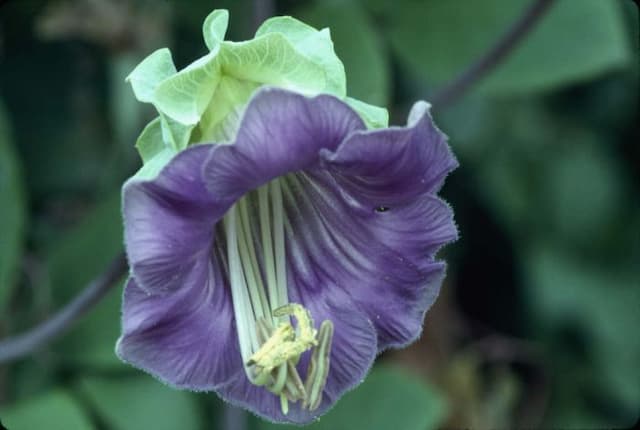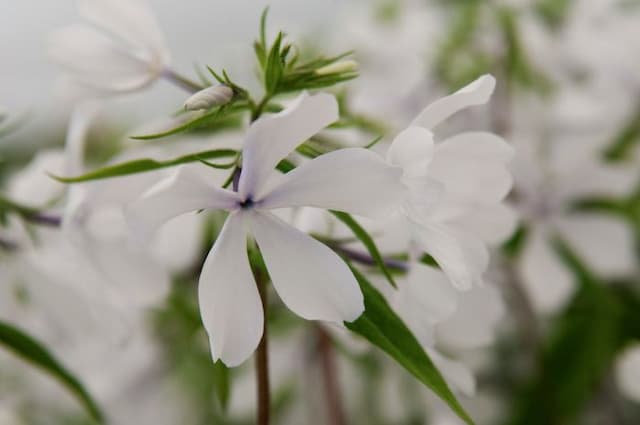Jacob's Ladder Polemonium 'Blue Pearl'

ABOUT
Polemonium 'Blue Pearl', widely known as Jacob's Ladder, is a charming perennial plant that boasts a compact and bushy growth habit. Its foliage consists of a series of pinnate leaves that are arranged in a ladder-like formation, a feature that is reflective of its common name. The leaves are often a bright and vibrant green, providing a lush backdrop for the blooms. The most striking characteristic of the Jacob's Ladder is its flowers. It produces clusters of bell-shaped flowers that are a delicate shade of blue, offering a soft contrast against the foliage. Each flower is composed of a series of rounded petals that unfurl from a tubular base, and they are often described as having a subtle, graceful appearance. These blossoms tend to form at the tips of the stems, creating a pleasing visual effect as if they are floating above the greenery. Overall, the Polemonium 'Blue Pearl' is a plant that captivates with its serene blue flowers and elegant foliage, making it a popular choice for gardeners looking to add a touch of tranquility to their planting schemes.
About this plant
 Names
NamesSynonyms
Jacob's Ladder, Blue Pearl Jacob's Ladder.
Common names
Polemonium 'Blue Pearl'.
 Toxicity
ToxicityTo humans
The Polemonium 'Blue Pearl', commonly known as Jacob's Ladder, is not generally considered toxic to humans. There are no well-documented cases or reports of poisoning from the ingestion of this plant. Therefore, it is unlikely to cause adverse effects if accidentally consumed in small quantities. However, as with any plant material, individual allergies and sensitivities can play a role, and some people might experience mild stomach upset or dermatitis upon handling or ingesting. It is always advisable to keep plants out of reach of young children who might ingest them out of curiosity.
To pets
Jacob's Ladder (Polemonium 'Blue Pearl') is not commonly known to be toxic to pets. There are no specific reports or indications that this plant would pose a significant risk to dogs, cats, or other household animals. Nevertheless, ingestion of non-food items can potentially lead to gastrointestinal irritation for pets, which may cause symptoms such as vomiting or diarrhea. To ensure the safety and well-being of pets, it's always best to discourage them from eating plants not intended for consumption and monitor their behavior around house and garden plants.
 Characteristics
CharacteristicsLife cycle
Perennials
Foliage type
Deciduous
Color of leaves
Green
Flower color
Blue
Height
1-2 feet (30-60 cm)
Spread
1 foot (30 cm)
Plant type
Herb
Hardiness zones
3
Native area
North America
Benefits
 General Benefits
General Benefits- Attractive Flowers: Polemonium 'Blue Pearl', commonly known as Jacob's Ladder, produces beautiful clusters of blue flowers that add a colorful touch to any garden or landscape.
- Easy to Grow: This plant is relatively easy to cultivate, making it suitable for gardeners of all skill levels.
- Attracts Pollinators: The blossoms attract bees, butterflies, and other pollinating insects, contributing to a healthy garden ecosystem.
- Shade Tolerance: Jacob's Ladder can thrive in partially shaded areas, providing flexibility in garden design and use in different light conditions.
- Compact Size: With its compact growth habit, it fits well in smaller gardens or as an underplanting for taller species.
- Seasonal Interest: It offers seasonal interest with its attractive foliage in spring and early summer bloom time.
- Non-Invasive: Jacob's Ladder is not known to be invasive, so it typically won’t crowd out other plants in the garden.
 Medical Properties
Medical PropertiesThis plant is not used for medical purposes.
 Air-purifying Qualities
Air-purifying QualitiesThis plant is not specifically known for air purifying qualities.
 Other Uses
Other Uses- Polemonium 'Blue Pearl', commonly known as Jacob's Ladder, can be used as an indicator plant in gardens to identify when the soil is too dry, as it wilts noticeably in dry conditions, prompting gardeners to water their plants.
- Its vibrant blue flowers can be used as a natural dye for fabrics or art projects, providing a soft blue hue to materials.
- Jacob's Ladder can be cultivated as a companion plant for vegetables and fruits in an edible garden, as its presence can attract pollinators like bees and butterflies.
- The foliage of Jacob's Ladder can be used in floral arrangements to provide a delicate, fern-like texture that contrasts with the bold colors of common cut flowers.
- The plant can serve as a living mulch, its dense foliage crowding out weeds and retaining soil moisture when planted in closely knit groups within a garden bed.
- Jacob's Ladder's attractive foliage can be used in pressed flower crafts, such as bookmarks or decorative cards, providing a unique lacy pattern to paper crafts.
- Gardeners sometimes use the plant for educational purposes to help identify plant structures, as its pinnately compound leaves are distinct and illustrate botany concepts clearly.
- Jacob's Ladder, because of its attractive form and color, may be used for ornamental purposes beyond the garden, such as in terrariums or small-scale landscapes.
- In photography, the distinctive stair-step leaf arrangement of Jacob's Ladder can serve as a subject for artistic photos that showcase symmetry and pattern in nature.
- The spent flowers and seed pods of Jacob's Ladder can be collected to create textured potpourri as a fragrant addition to home decor.
Interesting Facts
 Feng Shui
Feng ShuiThe Jacob's Ladder is not used in Feng Shui practice.
 Zodiac Sign Compitability
Zodiac Sign CompitabilityThe Jacob's Ladder is not used in astrology practice.
 Plant Symbolism
Plant Symbolism- Jacob's Ladder: The common name of Polemonium 'Blue Pearl' is Jacob's Ladder. This plant is often associated with the biblical story of Jacob's dream in which he saw a ladder reaching to heaven. Symbolically, it represents the connection between heaven and earth, as well as the path to enlightenment or understanding.
- Harmony: Its orderly leaf structure, resembling the ladder rungs, conveys a sense of balance and harmony, often used to symbolize the idea of achieving equilibrium in one's life.
- Peace: The soft blue flowers of Jacob's Ladder are commonly associated with tranquility and peace, suggesting a calming influence in one's life or garden area.
- Spiritual Thought: Due to its name and form, Jacob's Ladder is sometimes used as a symbol for deep contemplation, spiritual thought, or the journey of the soul towards enlightenment.
 Water
WaterThe Jacob's Ladder 'Blue Pearl' prefers consistently moist soil, so it's best to water it when the top inch of soil starts to dry out but don't let it become waterlogged. Water the plant thoroughly so that water reaches the root zone, which should be around one gallon every week, depending on the climate and the soil's ability to retain moisture. Avoid splashing water on the leaves to prevent disease, and during the growing season, increase watering to keep up with its needs, especially during dry spells.
 Light
LightJacob's Ladder 'Blue Pearl' thrives in full to partial shade conditions. The ideal spot for this plant is one that receives morning sun and afternoon shade, or dappled sunlight throughout the day, as too much direct sun can cause the foliage to scorch.
 Temperature
TemperatureJacob's Ladder 'Blue Pearl' prefers a temperature range between 60°F and 75°F for optimal growth. It can survive minimum temperatures down to around 50°F, but it should be protected from frost. Avoid exposing the plant to temperatures above 80°F for extended periods to prevent stress.
 Pruning
PruningPrune Jacob's Ladder 'Blue Pearl' to remove spent flower stalks and encourage a second bloom, as well as to maintain its shape and size. The best time to prune is after the first flowering in late spring or early summer. It may be necessary to prune lightly again in late summer if the plant becomes leggy or overgrown.
 Cleaning
CleaningAs needed
 Soil
SoilJacob's Ladder 'Blue Pearl' thrives best in a soil mix that offers good drainage, such as a combination of loamy soil, peat, and sand or perlite. The ideal pH range for this perennial is slightly acidic to neutral, around 5.8 to 6.8. Ensuring that the soil is rich in organic matter will promote healthy growth.
 Repotting
RepottingFor Jacob's Ladder 'Blue Pearl', repotting should be done every 2-3 years to prevent overcrowding and refresh the soil. It is best done in the springtime as the plant emerges from dormancy.
 Humidity & Misting
Humidity & MistingJacob's Ladder 'Blue Pearl' prefers a moderate humidity level but is quite adaptable and does not require specific humidity conditions. It can thrive in the average humidity found in most garden environments.
 Suitable locations
Suitable locationsIndoor
Place in bright, indirect light and water when the topsoil is dry.
Outdoor
Plant in partial shade, protect from harsh sun, and ensure well-draining soil.
Hardiness zone
3-8 USDA
 Life cycle
Life cycleThe life of the Jacob's Ladder 'Blue Pearl' begins with seed germination, typically when temperatures are cool in spring or fall. Following germination, it enters the seedling stage, where it develops its first true leaves and begins to establish a root system. As it grows, the plant enters the vegetative stage, where it develops a clump of fern-like foliage and strengthens its root structure. When mature enough, usually in late spring to early summer, it enters the flowering stage, producing clusters of bell-shaped, blue to violet flowers attractive to pollinators. After flowering, it sets seed, allowing for dispersal and new plant growth. Eventually, as temperatures cool in late fall, it enters dormancy, with above-ground growth dying back, and it survives as underground roots until the next growing season.
 Propogation
PropogationPropogation time
Spring-Early Summer
The most popular way to propagate the Jacob's Ladder 'Blue Pearl' variety is by division. Typically, the best time for division is in the spring, just as the plant begins to show signs of new growth. To divide Jacob's Ladder, carefully dig up the plant, ensuring you get as much of the root system as possible. Gently separate the plant into smaller clumps, making sure that each section has a portion of roots attached. Replant the divisions immediately at the same soil depth they were originally growing, spacing them about 12 to 18 inches (approximately 30 to 45 centimeters) apart to allow enough room for growth. Water the newly planted divisions thoroughly to help establish them. This method of propagation is quite straightforward and helps to rejuvenate older clumps that may have become too large or crowded.









